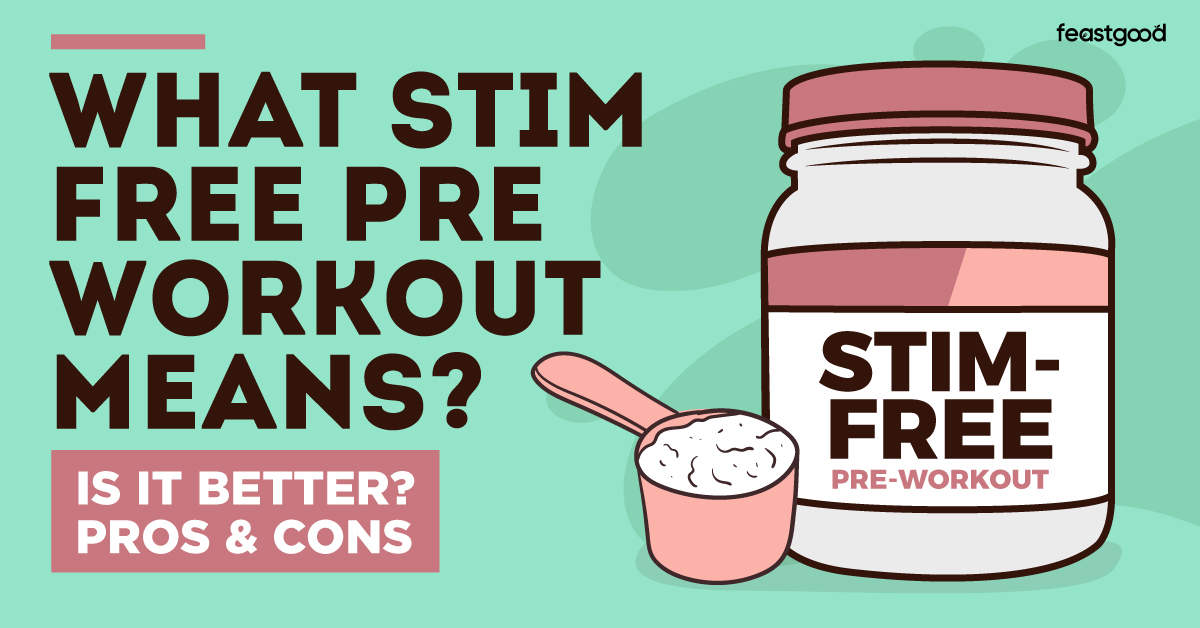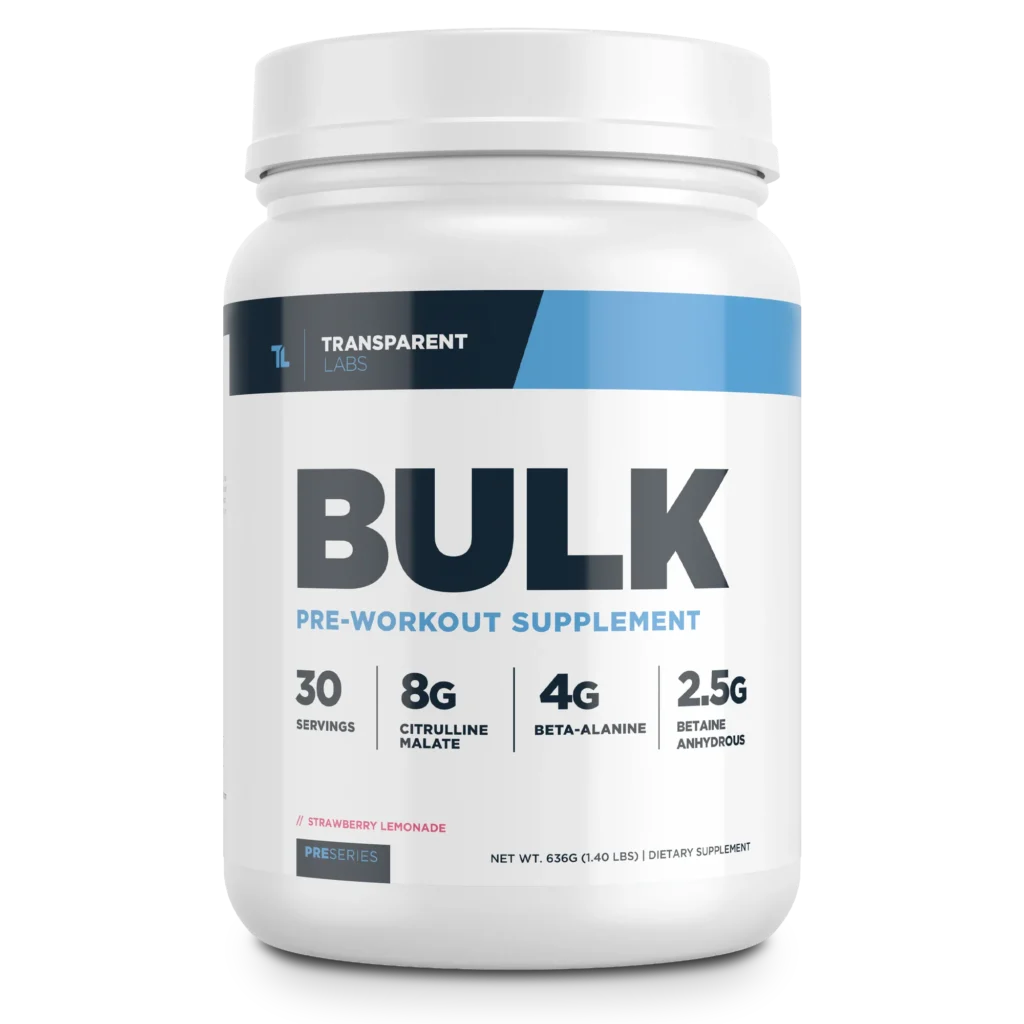Some links in this article are affiliate links, which means we earn from qualifying purchases. Learn more.
If you’re interested in pre-workouts, you may have noticed that some products are marketed as “stim-free. ” I’ll explain what stim-free pre-workouts are, their benefits, common ingredients, and whether they’re worth your hard-earned supplement dollars.
Key Takeaways
- Stim-free pre-workouts do not contain stimulants like caffeine. Instead, they contain ingredients that boost training performance without the jitteriness, anxiety, elevated heart rate, and potential sleep disruptions associated with stimulants.
- Stim-free pre-workout ingredients can improve workout performance, delay fatigue, and contribute to better muscle pumps (so long as they contain adequate dosing). However, they don’t have the same immediate and noticeable impact on energy levels and alertness.
- Stim-free pre-workouts are ideal for evening workouts to avoid sleep issues. They are also an excellent alternative for people who are sensitive to caffeine and those with elevated blood pressure.
Defining Stim-Free Pre-Workout
A ‘stim-free’ pre-workout is a supplement you can take before a workout to enhance your performance.
They come without the side effects of stimulants (caffeine being the most popular), like jitteriness, anxiety, increased heart rate, and poor sleep.
However, in purchasing a stimulant-free pre-workout, you’re also missing out on the boost in alertness, focus, and concentration that come from stimulants.
Common Ingredients In Stim-Free Pre-Workouts
The most common ingredients in stim-free pre-workouts include:
Citrulline
- What It Is: A naturally-occurring amino acid primarily found in watermelon.
- What It Does: It increases nitric oxide (NO) levels in the body. Nitric oxide is a vasodilator, which causes blood vessels to widen, improving blood flow to working muscles.
- Benefits: Supplementing with citrulline can improve exercise performance by boosting endurance and strength, delaying fatigue, improving muscle recovery, and even reducing muscle soreness.
- Dosing: Most research recommends a dose of eight grams taken approximately one hour before exercise.
Learn more about Citrulline in our in-depth guide.
Beta-Alanine
- What It Is: A naturally occurring amino acid known for producing carnosine (a molecule primarily found in the brain and muscles).
- What It Does: Data suggests that beta-alanine can increase carnosine levels by up to 85%. The carnosine produced thanks to beta-alanine serves as a buffer for hydrogen ions in the muscles, slowing acidosis (the drop in pH) during physical activity.
- Benefits: Beta-alanine can delay the burning sensation in our muscles during exercise and is primarily known to improve performance in the 1-4 minute range. Some researchers suggest it may be beneficial for any activity lasting 30 seconds to 10 minutes.
- Dosing: The recommended dose is 3.2 to 6.4 grams daily for it to build up in the body and lead to an increase in carnosine levels. The loading phase should last for two to four weeks, and folks can then transition to a maintenance dose of 1.2 grams daily.
Learn more about Beta-Alanine in our in-depth guide.
Betaine
- What It Is: A naturally occurring compound in whole grains, spinach, and beets.
- What It Does: It supports the production of carnitine (a compound essential for fat burning) and the breakdown of homocysteine (high levels of this amino acid are associated with some health risks).
- Benefits: Mixed findings suggest that betaine supplementation may improve muscle strength and power output. Some promising research also indicates that the compound may benefit body composition (i.e., helping people have more muscle and less fat).
- Dosing: A daily dose of 2.5g has been used in research.
L-Carnitine
- What It Is: A natural compound created in the body from two amino acids: lysine and methionine.
- What It Does: Carnitine has been shown to have anti-inflammatory and antioxidant effects. It’s also necessary for breaking down fatty acids for energy.
- Benefits: Research suggests that carnitine may reduce muscle damage from exercise and help the body burn fat more efficiently. Given its other properties, it can also protect healthy cells from stress and limit inflammation (which can help with muscle recovery and soreness).
- Dosing: Taking a daily dose of 2 grams for at least two weeks is recommended to experience the associated benefits.
L-Taurine
- What It Is: An amino acid produced in the body and found in certain foods like meat, fish, and dairy.
- What It Does: It supports various bodily processes, such as maintaining fluid balance, keeping cells hydrated, and widening blood vessels to improve blood flow.
- Benefits: Research suggests that taurine may reduce exercise-induced muscle damage, limit soreness, improve endurance, and boost muscle strength.
- Dosing: One to three grams daily, taken one to two hours before training.
Learn more about L-Taurine in our in-depth guide.
L-Tyrosine
- What It Is: A non-essential amino acid created in the body from another amino acid: phenylalanine.
- What It Does: It helps the body produce the neurotransmitters dopamine and norepinephrine, which are necessary for sleep, cognition, stress management, and motivation.
- Benefits: Data suggests that a single tyrosine dose can delay fatigue and increase the total amount of work you can do.
- Dosing: It’s suggested to be 100-150 mg per kilogram of body weight. A 90-kilo (200-lb) bodybuilder would need 9 to 13.5 grams. However, smaller doses may also be effective.
Here’s what pro bodybuilder and coach Dr. Eric Trexler wrote L-Tyrosine:
“When they design these studies, they need to make sure they give a very robust dose so they don’t do this whole study and wonder, ‘What if we did a few hundred milligrams extra? Is it possible we wasted our time on this? So, you go on the higher end of what we believe to be a safe dose….I think 10 to 15 grams of tyrosine might be overkill when it comes to exercise applications.”
BCAA
- What It Is: Branched-chain amino acids (BCAAs) are a group of three essential amino acids the body cannot produce on its own: leucine, isoleucine, and valine. They make up nearly a third of the protein in your muscles.
- What It Does: Leucine, in particular, plays a crucial role in muscle protein synthesis. All three may be broken down inside our muscles and used for energy during physical activity.
- Benefits: Some research suggests that BCAAs can help support muscle growth and maintenance, but that benefit is obsolete when eating enough protein (at least 0.7-0.8 grams per pound).
- Dosing: BCAA dosage is recommended at 85 mg of total BCAAs per kilogram of body weight daily, in a ratio of 2:1:1 for leucine, isoleucine, and valine. However, supplementation is necessary if meeting 0.7-1.2g of protein per pound of bodyweight from whole food protein sources.
Creatine
- What It Is: Creatine is an organic compound produced in the body from three amino acids: methionine, glycine, and arginine.
- What It Does: It plays a crucial role in energy production, especially during more intense physical activity when the body breaks down the available ATP (energy molecules) up to 1,000 times faster.
- Benefits: As one of the most thoroughly studied supplements, creatine has been shown to improve athletic performance during more intense activities (e.g., weight lifting, spriting, and cycling trials). It may also speed up muscle recovery and boost cognitive function.
- Dosing: A standard dose of 3 to 5 grams daily with an optional loading phase of 20-25 grams daily for five to seven days. A loading phase allows muscle creatine levels to increase more quickly, but the same will happen (albeit more slowly) with a standard dose.
Alpha-GPC
- What It Is: A form of choline (a nutrient found in many foods and involved in various bodily processes) and a precursor to acetylcholine––a neurotransmitter necessary for memory, attention, and learning.
- What It Does: The idea is that by supplementing with alpha-GPC, your body can more effectively produce acetylcholine and increase levels of that substance in the body.
- Benefits: The compound has mostly been studied in aging populations for cognitive improvements. However, some early research suggests it also improves power output.
- Dosing: According to Examine.com, the recommended dose is 300-600 mg, taken up to an hour before exercise.
Sodium Bicarbonate
- What It Is: Sodium bicarbonate, also known as baking soda, is a chemical product with a pH of 9, which makes it alkaline rather than acidic.
- What It Does: Among its roles, baking soda is a buffer for hydrogen ions. It slows the build-up of metabolic by-products in your muscles during exercise and delays the drop in muscle pH (acidosis). The effect is similar to that of beta-alanine and carnosine.
- Benefits: Sodium bicarbonate has been suggested to delay fatigue and may improve performance during short, intense activities, as well as longer, less intense types of exercise.
- Dosing: The recommended dose is 0.3 grams per kilogram of body weight taken one to three hours before exercise. For a 90-kilo (200-lb) person, that would be 27 grams or approximately two tablespoons.
Theanine
- What It Is: An amino acid primarily found in tea leaves and known to promote relaxation without leading to drowsiness.
- What It Does: It may limit the activity of neurotransmitters linked to anxiety and worry while increasing the role of brain chemicals related to well-being: serotonin and dopamine.
- Benefits: The amino acid may boost concentration, limit anxiety, and help offset some adverse effects of high caffeine doses (e.g., jitteriness).
- Dosing: The recommended daily dose is 200 to 400 mg. It may become more effective when taken over a more extended period (say, longer than two to three weeks).
Learn more about Theanine in our in-depth guide.
Difference Between Stimulant vs. Stimulant-Free Pre-Workouts
The primary differences between stimulant and stim-free pre-workouts lie in their formulas and intended use.
Formula Differences
Stimulant pre-workouts contain caffeine and/or other stimulants, such as yohimbe and theobromine. The exact dosage varies between products, so it’s best to check the label.
For instance, Transparent Labs BULK Pre Workout has 180 mg of caffeine, the equivalent of two cups of coffee, the average daily caffeine intake for 85% of adult Americans.
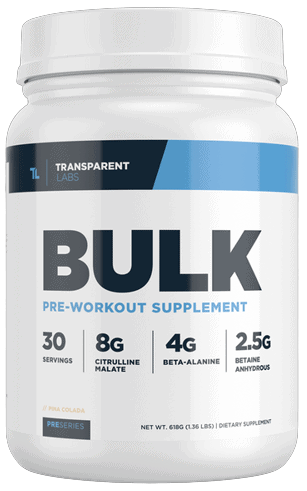
However, Legion Athletic Pulse Pre Workout, another stimulant pre-workout, has almost double the caffeine at 350 mg per scoop.
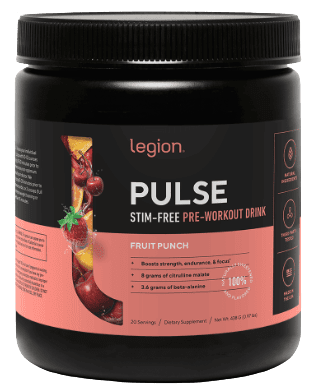
In contrast, stim-free pre-workout products rely primarily on other compounds (e.g., citrulline and beta-alanine) that may improve performance differently.
Stimulant pre-workouts often contain the same performance-enhancing ingredients as stim-free pre-workouts, which begs the question, “Aren’t stimulant pre-workouts better than stim-free ones since they have more ingredients that can help?”
It’s a complex question with multiple factors to consider. I’ll break it down in the following points.
- Related: 8 Best Low Caffeine Pre-Workouts
Effects On the Body
Stimulant pre-workouts reach peak impact on energy levels, motivation, and workout performance within 30-60 minutes of ingestion.
However, they may also lead to anxiety, jitteriness, an elevated heart rate, and sleep problems (especially if taken too close to bedtime).
In contrast, stim-free pre-workouts lead to a more gradual increase in energy levels and may substantially impact recovery and muscle pumps. However, they are unlikely to promote increased alertness or concentration.
One common effect of both types of pre-workouts is the skin-tingling sensation (paresthesia) from beta-alanine. However, that’s neither dangerous nor long-lasting (it typically goes away within an hour).
Effectiveness of Stim-Free Pre-Workouts
Both stimulant and stim-free free pre-workouts are effective for improving performance; the one that will be most effective depends on your needs and preferences.
First, it’s essential to understand that a lack of stimulants doesn’t mean a lack of benefits, as plenty of compounds can improve focus, athletic performance, and muscle pumps.
For instance, some compounds in stim-free pre-workouts (e.g., theanine) can contribute to a zen-like ‘flow’ state, where you can more easily focus on your workout and eliminate distractions.
Second, you may also be in for a pleasant surprise because these products often have ingredients to help you get a better pump during training.
Citrulline malate is a prominent example, as it can boost nitric oxide (NO) production, allowing blood vessels to widen and leading to better blood flow to the muscles.
Third, some stim-free pre-workout ingredients can improve power output (sodium bicarbonate, alpha-GPC, and creatine) and endurance (beta-alanine, sodium bicarbonate, and tyrosine).
Here’s what our in-house supplement review, Jenn Vibert, wrote in her review on the stim-free Gorilla Mode Nitric pre-workout:
“When using Gorilla Mode Nitric, I felt reasonably strong for my big compound lifts (squats, deadlifts, bench presses, rows/pulls, etc). I didn’t feel “superhuman” strength, but I could hit all of my prescribed sets and reps comfortably.”
Benefits of Stim-Free Pre-Workout
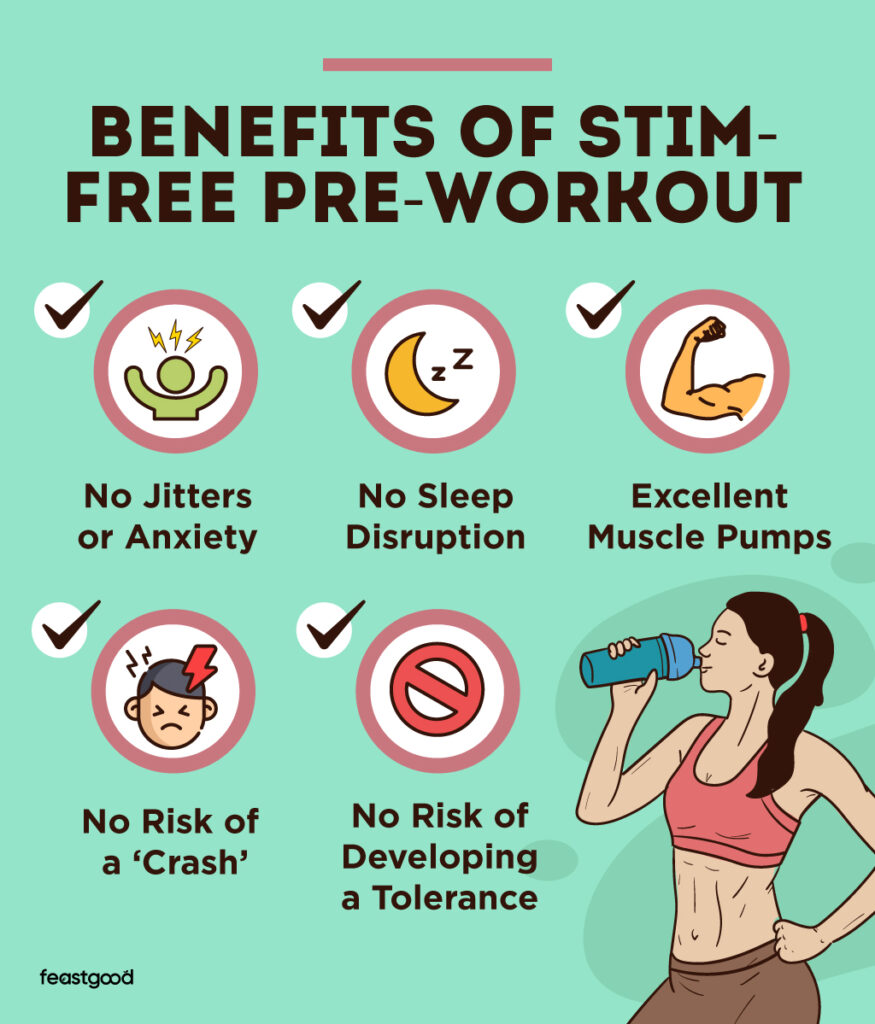
The benefits of stim-free pre-workout include:
No Jitters or Anxiety
The first obvious benefit of stim-free pre-workout is that the risk of side effects like jitters and anxiety is almost non-existent.
These symptoms typically result from higher doses of stimulants like caffeine and Yohimbe.
No Sleep Disruption
The lack of stimulants means stim-free formulas won’t impair your sleep if you take a scoop or two before your late afternoon or evening workout.
In contrast, research has established that stimulants (caffeine, in particular) can make it more challenging to get enough deep sleep.
Sleep issues can arise even if you’ve consumed caffeine hours before bedtime, as caffeine has a half-life of roughly 5 hours.
For example, if you ingest 350 mg (say, a scoop of Legion Athletic Pulse) at 5 PM, you may still have 170-180 mg coursing through your system at 10 PM.
Excellent Muscle Pumps
With a clinically effective dose of 8 grams, citrulline malate promotes blood flow and can produce fantastic muscle pumps that feel good and may contribute to growth.
Additionally, given the performance-enhancing effects of other ingredients (e.g., beta-alanine, sodium bicarbonate, taurine, and tyrosine), you may be able to do more total reps, which can further contribute to the pump.
No Risk of a ‘Crash’
Stimulant pre-workouts may offer a more noticeable boost in performance, but that can sometimes come at a price: an energy crash.
For instance, caffeine temporarily blocks adenosine receptors in the brain, inducing a state of alertness and reducing perceived pain. However, as the effect wears off, you may experience tiredness as your body returns to a normal, post-stimulated state.
In contrast, stim-free pre-workouts often boost performance in a more gradual and subdued way, making you less likely to feel exceptionally good or bad.
No Risk of Developing a Tolerance
The human body generally builds a tolerance to stimulants like caffeine, meaning their effects become less pronounced over time, and the dose needs to increase to continue providing benefits.
To avoid this, you can cycle off stimulants from time to time (say, taking a whole week off every month) to increase the body’s sensitivity to such compounds.
The great thing about stim-free pre-workouts is there is no risk of building up a tolerance because the ingredients inside don’t have that effect on the body.
Drawbacks of Stim-Free Pre-Workout
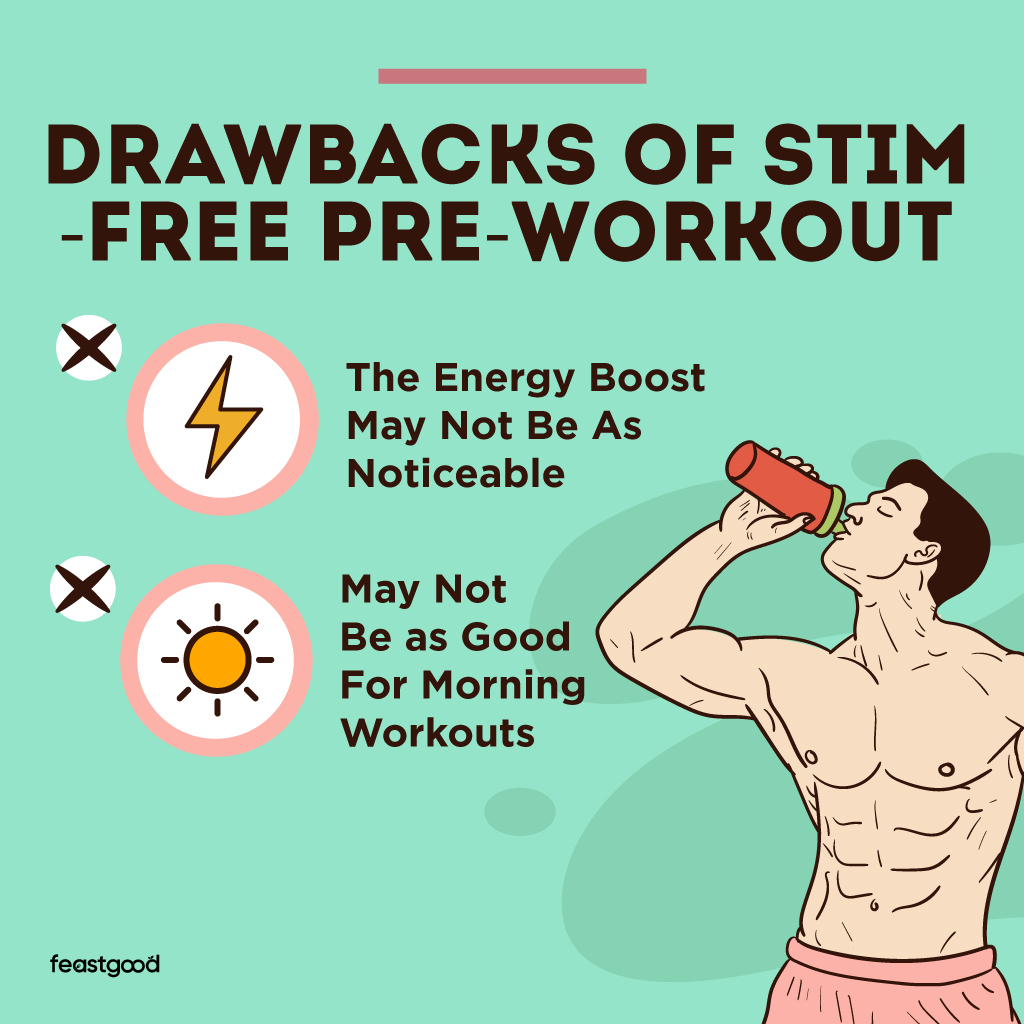
The drawbacks of a stim-free pre-workout include:
The Energy Boost May Not Be As Noticeable
Stimulant pre-workouts, especially those with more caffeine, can provide a real kick and almost instantly boost your energy levels, alertness, and mood.
However, we can’t say the same for stim-free products, as their effects are more gradual, and you may not feel different until it’s time to lift weights and you notice that you can do more work before getting tired.
The ingredients in a stim-free pre workout have a more subtle impact. Plus, certain compounds, such as beta-alanine and creatine, must be taken consistently to build up in your body and offer benefits.
May Not Be as Good For Morning Workouts
If you take a pre-workout supplement to wake up before morning workouts, stim-free products may not be the best option as they lack ingredients that will boost your alertness to the same extent as stimulants.
Jenn Vibert said this about Transparent Labs Stim-Free in her review:
“This product does not provide a substantial boost to energy or mental focus, but it’s not really designed to. It did provide good physical energy and stamina, but since it is a stimulant-free formula, it isn’t a great option to wake you up and give you a mental boost.”
Who Should Consider Stim-Free Pre-Workout?
Stim-free pre-workouts are an excellent alternative for people looking to optimize their performance at the gym while reducing the risk of potential side effects from stimulants: anxiety, jitteriness, and an elevated heart rate.
Existing health conditions can also play a role. For instance, someone with elevated blood pressure (hypertension) may want to limit or avoid stimulants, as they can further contribute to the issue.
Sim-free pre-workouts are also ideal for people who work out in the evening and don’t want caffeine to interfere with their sleep and negatively impact recovery.
You may also choose a stim-free pre-workout if you want a performance-boosting product you can take year-round without worrying about building a tolerance.
Stim-Free Pre Workout Recommendation
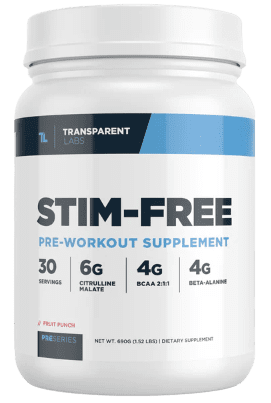
Transparent Labs Stim-Free Pre-Workout is one of the best stim-free options because it’s reasonably priced, contains high-quality ingredients, and is tested for label accuracy.
Despite lacking stimulants, it includes clinically effective doses of ingredients with scientific backing, including citrulline malate, beta-alanine, betaine anhydrous, and taurine.
These ingredients support athletic performance and help you have better pumps during training without bringing the common side effects of stimulants.
It costs $1.66 per serving, just $0.05 more expensive than the average serving of over 50 pre-workouts. It’s also cheaper than other clinically dosed pre-workouts that typically cost around $2 per serving.
Frequently Asked Questions
Can a stimulant-free pre-workout still provide a significant energy boost?
A stim-free pre-workout can still boost your energy levels, though not in the same way as stimulants.
Ingredients like beta-alanine and citrulline malate can increase your exercise capacity, allowing you to do more productive training before you get tired.
Are stimulant-free pre-workouts safer or healthier than their counterparts?
Stim-free pre-workouts are generally considered safer, especially for people with a sensitivity to stimulants and those with health conditions like elevated blood pressure.
They come with a lower risk of side effects like anxiety, jitteriness, and sleep loss.
Does non-stim pre-workout make you tingle?
Tingling or itching (known as paresthesia) typically results from beta-alanine, so there is still a risk of experiencing this with a stim-free pre-workout.
To avoid this, you can go for a stim-free pre-workout that doesn’t have beta-alanine, like Gorilla Mode Nitric.
Can you take a stim-free pre-workout even on rest days?
You can take a stim-free pre-workout on rest days, as it can help increase levels of beta-alanine and creatine in your body.
That said, pre-workouts are traditionally designed to be taken before training to boost your training performance.
References
Rhim HC, Kim SJ, Park J, Jang KM. Effect of citrulline on post-exercise rating of perceived exertion, muscle soreness, and blood lactate levels: A systematic review and meta-analysis. J Sport Health Sci. 2020 Dec;9(6):553-561. doi: 10.1016/j.jshs.2020.02.003. Epub 2020 Feb 8. PMID: 33308806; PMCID: PMC7749242.
Gonzalez, Adam M.1; Trexler, Eric T.2. Effects of Citrulline Supplementation on Exercise Performance in Humans: A Review of the Current Literature. Journal of Strength and Conditioning Research 34(5):p 1480-1495, May 2020. | DOI: 10.1519/JSC.0000000000003426
Bellinger PM. β-Alanine supplementation for athletic performance: an update. J Strength Cond Res. 2014 Jun;28(6):1751-70. doi: 10.1519/JSC.0000000000000327. PMID: 24276304.
Jayawardena R, Weerasinghe K, Sooriyaarachchi P, Hills AP. Effect of the beta-alanine supplementation in sports: an umbrella review of systematic reviews and meta-analyses. Med Sport 2023;76:260-71. DOI: 10.23736/S0025-7826.23.04276-X
Trexler ET, Smith-Ryan AE, Stout JR, Hoffman JR, Wilborn CD, Sale C, Kreider RB, Jäger R, Earnest CP, Bannock L, Campbell B, Kalman D, Ziegenfuss TN, Antonio J. International society of sports nutrition position stand: Beta-Alanine. J Int Soc Sports Nutr. 2015 Jul 15;12:30. doi: 10.1186/s12970-015-0090-y. PMID: 26175657; PMCID: PMC4501114.
Van Every, Derrick W. BS1; Plotkin, Daniel L. BS1; Delcastillo, Kenneth BS1; Cholewa, Jason PhD2; Schoenfeld, Brad J. PhD1. Betaine Supplementation: A Critical Review of Its Efficacy for Improving Muscle Strength, Power, and Body Composition. Strength and Conditioning Journal 43(4):p 53-61, August 2021. | DOI: 10.1519/SSC.0000000000000622
Cholewa JM, Wyszczelska-Rokiel M, Glowacki R, Jakubowski H, Matthews T, Wood R, Craig SA, Paolone V. Effects of betaine on body composition, performance, and homocysteine thiolactone. J Int Soc Sports Nutr. 2013 Aug 22;10(1):39. doi: 10.1186/1550-2783-10-39. PMID: 23967897; PMCID: PMC3844502.
Lee EC, Maresh CM, Kraemer WJ, Yamamoto LM, Hatfield DL, Bailey BL, Armstrong LE, Volek JS, McDermott BP, Craig SA. Ergogenic effects of betaine supplementation on strength and power performance. J Int Soc Sports Nutr. 2010 Jul 19;7:27. doi: 10.1186/1550-2783-7-27. PMID: 20642826; PMCID: PMC2915951.
Giamberardino, M. A., Dragani, L., Valente, R., Di Lisa, F., Saggin, R., & Vecchiet, L. (1996). Effects of prolonged L-carnitine administration on delayed muscle pain and CK release after eccentric effort. International Journal of Sports Medicine, 17(5), 320-324. doi: 10.1055/s-2007-972854
Rastgoo S, Fateh ST, Nikbaf-Shandiz M, Rasaei N, Aali Y, Zamani M, Shiraseb F, Asbaghi O. The effects of L-carnitine supplementation on inflammatory and anti-inflammatory markers in adults: a systematic review and dose-response meta-analysis. Inflammopharmacology. 2023 Oct;31(5):2173-2199. doi: 10.1007/s10787-023-01323-9. Epub 2023 Sep 1. PMID: 37656233.
Vecchio M, Chiaramonte R, Testa G, Pavone V. Clinical Effects of L-Carnitine Supplementation on Physical Performance in Healthy Subjects, the Key to Success in Rehabilitation: A Systematic Review and Meta-Analysis from the Rehabilitation Point of View. J Funct Morphol Kinesiol. 2021 Nov 4;6(4):93. doi: 10.3390/jfmk6040093. PMID: 34842765; PMCID: PMC8628984.
Kurtz, J.A., VanDusseldorp, T.A., Doyle, J.A. et al. Taurine in sports and exercise. J Int Soc Sports Nutr 18, 39 (2021). https://doi.org/10.1186/s12970-021-00438-0
Tumilty, L., Davison, G., Beckmann, M. et al. Oral tyrosine supplementation improves exercise capacity in the heat. Eur J Appl Physiol 111, 2941–2950 (2011). https://doi.org/10.1007/s00421-011-1921-4
Garlick, P. J. (2005). The Role of Leucine in the Regulation of Protein Metabolism. The Journal of Nutrition, 135(6), 1553S-1556S. https://doi.org/10.1093/jn/135.6.1553S
Stokes T, Hector AJ, Morton RW, McGlory C, Phillips SM. Recent Perspectives Regarding the Role of Dietary Protein for the Promotion of Muscle Hypertrophy with Resistance Exercise Training. Nutrients. 2018 Feb 7;10(2):180. doi: 10.3390/nu10020180. PMID: 29414855; PMCID: PMC5852756.
Baker JS, McCormick MC, Robergs RA. Interaction among Skeletal Muscle Metabolic Energy Systems during Intense Exercise. J Nutr Metab. 2010;2010:905612. doi: 10.1155/2010/905612. Epub 2010 Dec 6. PMID: 21188163; PMCID: PMC3005844.
Cooper R, Naclerio F, Allgrove J, Jimenez A. Creatine supplementation with specific view to exercise/sports performance: an update. J Int Soc Sports Nutr. 2012 Jul 20;9(1):33. doi: 10.1186/1550-2783-9-33. PMID: 22817979; PMCID: PMC3407788.
Naderi A, de Oliveira EP, Ziegenfuss TN, Willems MT. Timing, Optimal Dose and Intake Duration of Dietary Supplements with Evidence-Based Use in Sports Nutrition. J Exerc Nutrition Biochem. 2016 Dec 31;20(4):1-12. doi: 10.20463/jenb.2016.0031. PMID: 28150472; PMCID: PMC5545206.
Sam C, Bordoni B. Physiology, Acetylcholine. [Updated 2023 Apr 10]. In: StatPearls [Internet]. Treasure Island (FL): StatPearls Publishing; 2024 Jan-. Available from: https://www.ncbi.nlm.nih.gov/books/NBK557825/
Parker, A.G., Byars, A., Purpura, M. et al. The effects of alpha-glycerylphosphorylcholine, caffeine or placebo on markers of mood, cognitive function, power, speed, and agility. J Int Soc Sports Nutr 12 (Suppl 1), P41 (2015). https://doi.org/10.1186/1550-2783-12-S1-P41
Grgic, J., Pedisic, Z., Saunders, B. et al. International Society of Sports Nutrition position stand: sodium bicarbonate and exercise performance. J Int Soc Sports Nutr 18, 61 (2021). https://doi.org/10.1186/s12970-021-00458-w
Hidese S, Ogawa S, Ota M, Ishida I, Yasukawa Z, Ozeki M, Kunugi H. Effects of L-Theanine Administration on Stress-Related Symptoms and Cognitive Functions in Healthy Adults: A Randomized Controlled Trial. Nutrients. 2019 Oct 3;11(10):2362. doi: 10.3390/nu11102362. PMID: 31623400; PMCID: PMC6836118.
Sakamoto, F. L., Ribeiro, R. M. P., Bueno, A. A., & Santos, H. O. (2019). Psychotropic effects of L-theanine and its clinical properties: From the management of anxiety and stress to a potential use in schizophrenia. Pharmacological Research, 147, 104395. https://doi.org/10.1016/j.phrs.2019.104395
Temple JL, Bernard C, Lipshultz SE, Czachor JD, Westphal JA, Mestre MA. The Safety of Ingested Caffeine: A Comprehensive Review. Front Psychiatry. 2017 May 26;8:80. doi: 10.3389/fpsyt.2017.00080. PMID: 28603504; PMCID: PMC5445139.
Cappelletti S, Piacentino D, Sani G, Aromatario M. Caffeine: cognitive and physical performance enhancer or psychoactive drug? Curr Neuropharmacol. 2015 Jan;13(1):71-88. doi: 10.2174/1570159X13666141210215655. Erratum in: Curr Neuropharmacol. 2015;13(4):554. Daria, Piacentino [corrected to Piacentino, Daria]. PMID: 26074744; PMCID: PMC4462044.
Liu Q, Sikand P, Ma C, Tang Z, Han L, Li Z, Sun S, LaMotte RH, Dong X. Mechanisms of itch evoked by β-alanine. J Neurosci. 2012 Oct 17;32(42):14532-7. doi: 10.1523/JNEUROSCI.3509-12.2012. PMID: 23077038; PMCID: PMC3491570.
Li MY, Liu HY, Wu DT, Kenaan A, Geng F, Li HB, Gunaratne A, Li H, Gan RY. L-Theanine: A Unique Functional Amino Acid in Tea (Camellia sinensis L.) With Multiple Health Benefits and Food Applications. Front Nutr. 2022 Apr 4;9:853846. doi: 10.3389/fnut.2022.853846. PMID: 35445053; PMCID: PMC9014247.
Theodorou AA, Zinelis PT, Malliou VJ, Chatzinikolaou PN, Margaritelis NV, Mandalidis D, Geladas ND, Paschalis V. Acute L-Citrulline Supplementation Increases Nitric Oxide Bioavailability but Not Inspiratory Muscle Oxygenation and Respiratory Performance. Nutrients. 2021 Sep 22;13(10):3311. doi: 10.3390/nu13103311. PMID: 34684312; PMCID: PMC8537281.
Gardiner, C., Weakley, J., Burke, L. M., Roach, G. D., Sargent, C., Maniar, N., Townshend, A., & Halson, S. L. (2023). The effect of caffeine on subsequent sleep: A systematic review and meta-analysis. Sleep Medicine Reviews, 69, 101764. https://doi.org/10.1016/j.smrv.2023.101764
Institute of Medicine (US) Committee on Military Nutrition Research. Caffeine for the Sustainment of Mental Task Performance: Formulations for Military Operations. Washington (DC): National Academies Press (US); 2001. 2, Pharmacology of Caffeine. Available from: https://www.ncbi.nlm.nih.gov/books/NBK223808/
Lara B, Ruiz-Moreno C, Salinero JJ, Del Coso J. Time course of tolerance to the performance benefits of caffeine. PLoS One. 2019 Jan 23;14(1):e0210275. doi: 10.1371/journal.pone.0210275. PMID: 30673725; PMCID: PMC6343867.
Geleijnse JM. Habitual coffee consumption and blood pressure: an epidemiological perspective. Vasc Health Risk Manag. 2008;4(5):963-70. doi: 10.2147/vhrm.s3055. PMID: 19183744; PMCID: PMC2605331.
About The Author

Philip Stefanov is a certified conditioning coach, personal trainer, and fitness instructor. With more than nine years of experience in the industry, he’s helped hundreds of clients improve their nutritional habits, become more consistent with exercise, lose weight in a sustainable way, and build muscle through strength training. He is passionate about writing and has published more than 500 articles on various topics related to healthy nutrition, dieting, calorie and macronutrient tracking, meal planning, fitness and health supplementation, best training practices, and muscle recovery.
Why Trust Our Content

On Staff at FeastGood.com, we have Registered Dietitians, coaches with PhDs in Human Nutrition, and internationally ranked athletes who contribute to our editorial process. This includes research, writing, editing, fact-checking, and product testing/reviews. At a bare minimum, all authors must be certified nutrition coaches by either the National Academy of Sports Medicine, International Sport Sciences Association, or Precision Nutrition. Learn more about our team here.
Have a Question?
If you have any questions or feedback about what you’ve read, you can reach out to us at [email protected]. We respond to every email within 1 business day.
